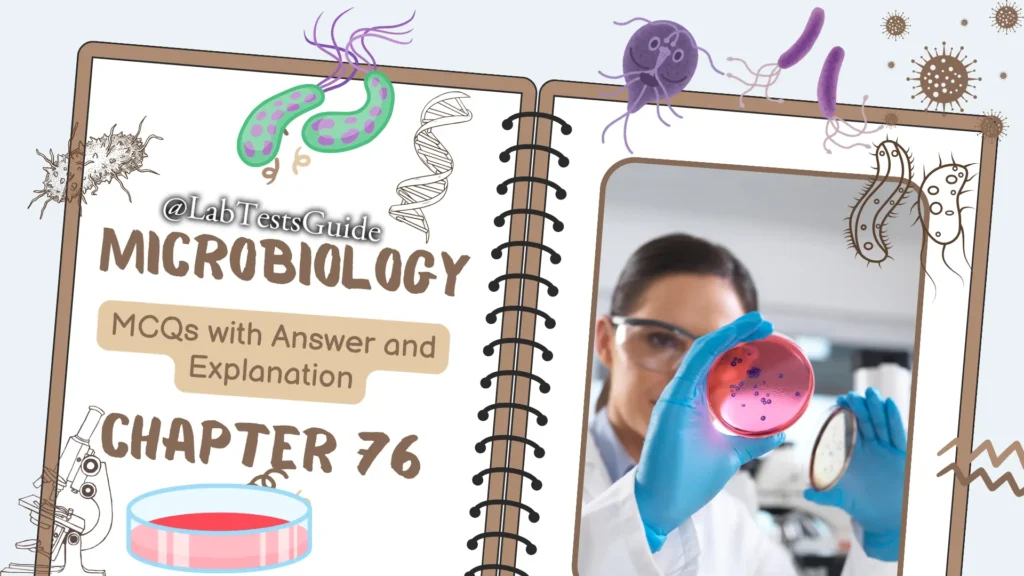Chapter 76 with our Microbiology MCQs and explanations! Test your knowledge and understanding of key concepts with our complete set of multiple choice questions with detailed explanations for each answer. Increase your confidence and understanding of the fascinating world of microorganisms!

Microbiology is the study of living organisms that are not visible to the naked eye. All microorganisms such as amoebae, protozoa, viruses, bacteria are studied in microbiology. Microbes play a major role in nutrient cycling, decomposition, food spoilage, disease control and causation, and biotechnology. Due to their versatile nature, they can be used for different purposes.
Below is a set of microbiology MCQs along with the answers for your reference. These will help students improve their conceptual knowledge.
Microbiology MCQs 3751 to 3765
- Tinea pedis is casued by?
- E floccosum
- T rubrum
- Microsporum
- T schoenleinii
Answer and Explanation
Answer: T rubrum
Tinea pedis, commonly known as athlete’s foot, is a fungal infection of the feet. Among the listed options, Trichophyton rubrum is the most common fungus that causes athlete’s foot.
The other options are incorrect:
- E. floccosum: While E. floccosum is also a fungus, it’s not typically associated with causing tinea pedis.
- Microsporum: Microsporum is another type of fungus, but it more commonly causes scalp ringworm than athlete’s foot.
- T. schoenleinii: T. schoenleinii is a fungus that can cause favus, a fungal infection of the scalp and sometimes the nails, but it’s not a common cause of athlete’s foot.
- Lyme disease is caused by
- Borrelia vincenti
- Borrelia burgdoferi
- Borrelia recurrentis
- Leptospira interrogans
Answer and Explanation
Answer: Borrelia burgdoferi
Lyme disease is a bacterial infection primarily caused by the bacterium Borrelia burgdorferi. This bacteria is transmitted through the bites of infected ticks.
The other options are incorrect:
- Borrelia vincenti: Borrelia vincentii is a different species of bacteria involved in gum infections (Vincent’s angina) and trench mouth.
- Borrelia recurrentis: Borrelia recurrentis is another type of bacteria that causes relapsing fever, a tick-borne illness with different symptoms compared to Lyme disease.
- Leptospira interrogans: Leptospira interrogans is a bacterium that causes leptospirosis, an infection with distinct symptoms from Lyme disease and spread through contact with contaminated water or animal urine.
- The only cell in normal CSF is
- Neutrophil
- Lymphocyte
- Manocyte
- None of these
Answer and Explanation
Answer: None of these
Normal Cerebrospinal Fluid (CSF) should ideally contain very few, if any, cells. It primarily functions as a protective cushion for the brain and spinal cord and doesn’t require a constant immune cell presence.
The other options are incorrect:
- Neutrophil: Neutrophils are a type of white blood cell that fights infections. Their presence in CSF can indicate inflammation or infection.
- Lymphocyte: Lymphocytes are another type of white blood cell involved in the immune response. An elevated level in CSF might suggest an infection or autoimmune disease.
- Monocyte: Monocytes are another type of white blood cell that can become macrophages and engulf foreign particles. Their presence in CSF could be a sign of inflammation or infection.
- Who is known as ‘father of microbiology’ ?
- Louis Pasteur
- Robert Koch
- Alexander Fleming
- Edward Jenner
Answer and Explanation
Answer: Louis Pasteur
Louis Pasteur is often referred to as the “father of microbiology” due to his pioneering work in the field, including the development of pasteurization, germ theory of disease, and vaccines.
The other options are incorrect:
- Robert Koch: Robert Koch made significant contributions to microbiology, particularly in the field of bacteriology and the development of Koch’s postulates, but he is not commonly referred to as the “father of microbiology.”
- Alexander Fleming: Alexander Fleming discovered penicillin, the first antibiotic, but he is not typically referred to as the “father of microbiology.”
- Edward Jenner: Edward Jenner developed the smallpox vaccine, which marked the beginning of immunology, but he is not commonly known as the “father of microbiology.”
- Cob-Web appearance of clot in CSF indicates
- Jaundice
- Haemorrhage
- Spinal constriction
- Tuberculous meningitis
Answer and Explanation
Answer: Tuberculous meningitis
A cobweb-like clot in Cerebrospinal Fluid (CSF) is a characteristic finding in tuberculous meningitis. This appearance is caused by a very high level of protein in the CSF, a hallmark of this type of meningitis caused by Mycobacterium tuberculosis bacteria.
The other options are incorrect:
- Jaundice: Jaundice refers to a yellowish discoloration of the skin and eyes caused by excess bilirubin in the blood. It wouldn’t cause a cobweb clot in the CSF.
- Haemorrhage: Hemorrhage in the CSF can cause a reddish tinge, but it wouldn’t typically have a cobweb-like appearance.
- Spinal constriction: Spinal constriction refers to narrowing of the spinal canal. While it can affect CSF flow, it wouldn’t directly cause a cobweb clot.
- All the following are motile bacteria except
- E.Coli
- Klebsiella
- Vibrio
- Proteus
Answer and Explanation
Answer: Klebsiella
Klebsiella is a non-motile bacterium. It lacks flagella and therefore cannot move independently.
The other options are incorrect:
- E. coli: Escherichia coli (E. coli) is a motile bacterium. It possesses flagella that enable it to move in liquid environments.
- Vibrio: Vibrio species, such as Vibrio cholerae, are motile bacteria. They have a single polar flagellum that allows them to move in aqueous environments.
- Proteus: Proteus species, like Proteus mirabilis, are motile bacteria. They possess peritrichous flagella, which cover the entire surface of the cell, enabling movement in various directions.
- Solidifying agent of a culture media is?
- peptone
- meat extract
- sodium chloride
- agar
Answer and Explanation
Answer: agar
Agar is the solidifying agent commonly used in culture media. It solidifies the liquid media, providing a semi-solid or solid surface for bacterial growth.
The other options are incorrect:
- Peptone: A protein source that provides essential nutrients for microbial growth.
- Meat Extract: Similar to peptone, a source of nutrients but doesn’t solidify the media.
- Sodium Chloride: An electrolyte that can affect microbial growth but doesn’t solidify the media.
- __ is added to Mac Conkeys agar to inhibit the growth of gram positive bacteria.
- Bile salt
- Peptone
- Neutral red
- Agar
Answer and Explanation
Answer: Bile salt
MacConkey agar contains bile salts, which are toxic to the cell membranes of most Gram-positive bacteria. This selectively inhibits their growth, allowing Gram-negative bacteria to thrive on the plate.
The other options are incorrect:
- Peptone: Peptone is a nutrient source for bacterial growth and is present in MacConkey agar to support bacterial growth, not inhibit it.
- Neutral red: Neutral red is a pH indicator dye used to differentiate lactose fermenting and non-fermenting bacteria. It doesn’t inhibit bacterial growth.
- Agar: Agar is a gelling agent that solidifies the liquid culture medium, allowing for colony formation and observation. It has no effect on bacterial growth.
- All the following are examples of transport media except
- VR medium
- Thioglycollate medium
- Stuarts medium
- Amies medium
Answer and Explanation
Answer: Thioglycollate medium
Thioglycollate medium is not a transport medium; it is a type of enrichment broth used for cultivating anaerobic bacteria and testing the oxygen tolerance of microorganisms.
The other options are incorrect:
- VR medium: VR medium, also known as Violet Red Bile agar, is a selective and differential medium used for the isolation and differentiation of gram-negative enteric bacteria. It is not a transport medium.
- Stuarts medium: Stuarts medium, also known as Stuart’s transport medium, is a type of transport medium used to maintain the viability of microorganisms during specimen transport. It is used for the transport of swabs and other clinical specimens.
- Amies medium: Amies medium, also known as Amies transport medium, is another type of transport medium used to preserve the viability of microorganisms during specimen transport. It is used for the transport of swabs and other clinical specimens.
- Which of the following tests come under IMViC tests ?
- Coagulase test
- Catalase test
- Citrate utilisation test
- None of above
Answer and Explanation
Answer: Citrate utilisation test
The IMViC tests stand for Indole, Methyl Red, Voges-Proskauer, and Citrate utilization. These are a series of biochemical tests used to differentiate between various Gram-negative bacteria, particularly members of the Enterobacteriaceae family.
The other options are incorrect:
- Coagulase test: This test identifies bacteria that produce coagulase, an enzyme that clots blood plasma. It’s used to differentiate Staphylococcus aureus from other Staphylococcus species and is not part of the IMViC battery.
- Catalase test: This rapid test detects the presence of the catalase enzyme, which breaks down hydrogen peroxide into water and oxygen. While it can be a helpful initial test, it’s not specific enough for identification within the Enterobacteriaceae and is not included in the IMViC scheme.
- The bacteria which require ‘X’ and ‘V’ factors for its growth is
- staphylococcus
- haemophilus
- brucella
- salmonella
Answer and Explanation
Answer: haemophilus
Haemophilus bacteria, such as Haemophilus influenzae, require both “X” factor (hemin) and “V” factor (nicotinamide adenine dinucleotide, NAD) for their growth. These factors are often provided in special media for the cultivation of Haemophilus species.
The other options are incorrect:
- Staphylococcus: Most Staphylococcus species are generally less fastidious and can grow on basic laboratory media without requiring X and V factors.
- Brucella: While Brucella can be somewhat fastidious, they typically don’t require X and V factors for growth. They have specific nutritional requirements but can often grow on enriched media.
- Salmonella: Similar to Staphylococcus, Salmonella species are generally not dependent on X and V factors for growth. They can thrive on basic or enriched media.
- RPR and VDRL tests are done for the diagnosis of
- AIDs
- Hepatitis
- Syphilis
- Malaria
Answer and Explanation
Answer: Syphilis
RPR (Rapid Plasma Reagin) and VDRL (Venereal Disease Research Laboratory) tests are serological tests used for the diagnosis of syphilis, a sexually transmitted infection caused by the bacterium Treponema pallidum.
The other options are incorrect:
- AIDS: RPR and VDRL tests are not used to diagnose AIDS (Acquired Immunodeficiency Syndrome). AIDS is caused by the Human Immunodeficiency Virus (HIV) and requires specific HIV antibody or antigen tests for diagnosis.
- Hepatitis: While some types of viral hepatitis can be transmitted sexually, RPR and VDRL tests are not used for their diagnosis. Specific tests for Hepatitis A, B, or C are needed for detection.
- Malaria: Malaria is a parasitic infection transmitted by mosquito bites. RPR and VDRL tests are irrelevant for diagnosing malaria as they target bacterial infections.
- Mycology’ means the study of
- bacteria
- immunity
- parasites
- fungus
Answer and Explanation
Answer: fungus
Mycology is the branch of biology concerned with the study of fungi, including their genetic and biochemical properties, taxonomy, ecology, and medical importance.
The other options are incorrect:
- Bacteria: Bacteriology is the branch of biology concerned with the study of bacteria.
- Immunity: Immunology is the field that studies the immune system and its response to foreign invaders like bacteria, viruses, and parasites.
- Parasites: Parasitology is the scientific discipline that explores parasites, organisms that live on or within another organism (host) and obtain nutrients from
- Intermediate host of plasmodium is
- man
- female anopheles mosquito
- male anopheles mosquito
- none of the above
Answer and Explanation
Answer: female anopheles mosquito
The female Anopheles mosquito is the intermediate host of Plasmodium, the parasite responsible for causing malaria. The mosquito acts as a vector, transmitting the Plasmodium parasites to humans through its bite.
The other options are incorrect:
- Man: While humans are the definitive host for Plasmodium, allowing the parasite to reproduce sexually, they are not the intermediate host.
- Male anopheles mosquito: Only female Anopheles mosquitoes take blood meals and thus play no role in the Plasmodium life cycle.
- None of the above: This is incorrect as the female Anopheles mosquito is the essential intermediate host for Plasmodium.
- The bacteria showing swarming growth is
- E.coli
- Salmonella
- Proteus
- All the above
Answer and Explanation
Answer: Proteus
Proteus bacteria are known for their characteristic swarming growth pattern on agar plates. This phenomenon occurs due to the coordinated movement of the bacteria across the agar surface, facilitated by flagella.
The other options are incorrect:
- E. coli: Escherichia coli (E. coli) typically does not exhibit swarming growth. While some strains of E. coli may display motility, they do not produce the extensive swarming seen in Proteus species.
- Salmonella: Salmonella bacteria generally do not demonstrate swarming growth. They are motile bacteria, but their motility patterns differ from those of Proteus, and they typically do not exhibit swarming behavior.
- All the above: While all of the options listed are bacteria, not all of them exhibit swarming growth. Only Proteus is known for its swarming behavior. Therefore, “All the above” is not the correct answer in this context.
The questions are typically designed to assess the technical skills and knowledge required for the laboratory profession, including the ability to analyze laboratory test results, perform laboratory procedures, and maintain laboratory equipment.
To prepare for these MCQs, candidates should have a thorough understanding of the key concepts and principles of laboratory science. They should also be familiar with common laboratory equipment and procedures, as well as laboratory safety protocols.
Candidates may also benefit from studying specific laboratory science textbooks or taking online courses that cover the material tested in the MCQs. Additionally, practicing sample MCQs and reviewing the answers can help candidates identify areas where they may need to improve their knowledge or skills.
Overall, the MCQs for lab technologists are designed to be challenging and comprehensive, requiring candidates to demonstrate a high level of proficiency in the field of laboratory science.
Possible References Used






there is some confusion in question and answer of microbiology 3754 that is who known as father of microbiology ? kindly clear this as the correct answer is antinie van leeuwenhoke as bacteria discovered by him and louis pastuer is known to be modern microbiology.
kindly explain and correct me also if am wrong.
thanks
Yes You are wright, But Antonie van Leeuwenhoek is not in 4 options thats why we give the correct answer”louis pastuer” from given options.
Thank you For response.